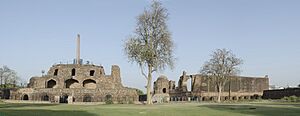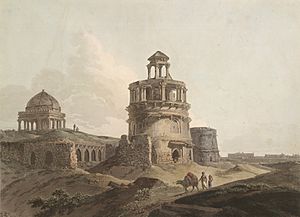Firuz Shah Tughlaq facts for kids
Quick facts for kids Firuz Shah Tughlaq |
|||||
|---|---|---|---|---|---|
| Firuz shah Tuglaq ibne Malik Rajjab | |||||

Firoz Shah Tughlaq making Dua
|
|||||
| 19th Sultan of Delhi | |||||
| Reign | 23 March 1351 – 20 September 1388 | ||||
| Predecessor | Muhammad bin Tughluq | ||||
| Successor | Tughluq Khan | ||||
| Born | 1309 | ||||
| Died | 20 September 1388 (aged 78–79) Jaunpur |
||||
| Burial | 20 September 1388 Tomb of Firoz Shah at Jaunpur, Jaunpur |
||||
| Issue |
|
||||
|
|||||
| House | Tughlaq | ||||
| Dynasty | Tughlaq dynasty | ||||
| Father | Malik Rajab | ||||
| Mother | Bibi Naila | ||||
| Religion | Islam | ||||
Sultan Firuz Shah Tughlaq (born 1309 – died 20 September 1388) was a Muslim ruler. He belonged to the Tughlaq dynasty. He ruled the Delhi Sultanate from 1351 to 1388.
He became Sultan after his cousin, Muhammad bin Tughluq, passed away. Muhammad bin Tughlaq had been in Sindh trying to stop a rebellion. When Firuz Shah became Sultan, no one really wanted to take charge. It was a difficult time. People in the camp had to convince Firuz to accept the role.
At first, a minister named Khwaja Jahan tried to put a young boy on the throne. He claimed the boy was Muhammad bin Tughlaq's son. But this plan didn't work out. Firuz Shah took over. Because there was so much trouble, his kingdom was smaller than his cousin's. He had to let areas like Bengal become independent due to many rebellions. Firuz Shah made Sharia (Islamic law) the main law in his kingdom.
Contents
Who Was Firuz Shah Tughlaq?
Firuz Shah Tughlaq's father was named Rajab. He was the younger brother of Ghiyath al-Din Tughlaq, who was also a ruler. His mother, Naila, was a princess from the Bhati Rajput family. She came from Dipalpur in Punjab.
How Firuz Shah Ruled
We know a lot about Firuz Shah Tughlaq from his own book. It was a 32-page autobiography called Futuhat-e-firozshahi. He was 42 years old when he became the Sultan of Delhi in 1351. He ruled for many years, until 1388.
When he became Sultan, there were many rebellions. These happened in places like Bengal, Gujarat, and Warangal. Even with these challenges, he worked hard to improve his empire. He built many useful things for his people. These included canals, places for travelers to rest, and hospitals. He also fixed old water reservoirs and dug new wells.
Firuz Shah founded several new cities near Delhi. Some of these cities were Jaunpur, Firozpur, Hissar, Firozabad, and Fatehabad. Much of Firozabad was later taken apart. Future rulers used its stones to build other structures. The rest of Firozabad became part of New Delhi as the city grew.
His Policies and Decisions
Firuz Shah Tughlaq was a very religious Muslim ruler. He tried to follow Islamic laws strictly. He made some important changes based on the advice of religious scholars. For example, he made non-Muslims pay a special tax called Jizya. He also stopped some practices that religious scholars thought were not Islamic. One example was stopping Muslim women from visiting saint's graves for worship. He also disagreed with some religious groups that were seen as different from the main Islamic beliefs.
Firuz Shah learned from the mistakes of his cousin, Muhammad Tughlaq. He decided not to try and win back areas that had become independent. He also chose not to stop other areas from gaining their freedom. He was known for being kind and fair as a Sultan. He wanted to keep the nobles (important leaders) and the Ulema (religious scholars) happy. This way, he hoped to rule his kingdom peacefully.
Some southern states had already broken away from the Sultanate. There were also rebellions in Gujarat and Sindh. Bengal had declared its independence. Firuz Shah led military trips against Bengal in 1353 and 1358. He captured Cuttack and made the ruler of Jajnagar in Odisha pay tribute. He also converted some Chauhan Rajputs from Hinduism to Islam. Today, they are known as Qaimkhanis in Rajasthan.
He also attacked Kangra Fort and made Nagarkot pay tribute. He did the same with Thatta.

Instead of giving jobs based on skill, Firuz Shah allowed a noble's son to take over his father's position. This also applied to the army. An old soldier could send his son, son-in-law, or even his slave to fight in his place. He also increased the pay for nobles. He stopped harsh punishments like cutting off hands. He also lowered the land taxes that Muhammad Tughlaq had raised. Some people say Firuz Shah's rule was a time when there was a lot of corruption. For example, he once gave a soldier a gold coin. This was so the soldier could bribe a clerk to approve his horse, which wasn't very good.
Building and Learning
Firuz Shah wanted to make life better for his people. He built many rest houses, gardens, and tombs. He also opened many madrasas (Islamic religious schools). These schools helped Muslims get a religious education. He set up hospitals that gave free treatment to poor people. He also supported doctors who worked on Unani medicine. He even provided money to help poor girls get married through a special department called Diwan-i-khairat.
He ordered the construction of many public buildings in Delhi. In 1354 CE, he built the Firoz Shah Palace Complex in Hisar. He also created over 300 villages. He dug five major canals, including fixing the old Western Yamuna Canal. These canals helped bring water for farming. This meant more land could be used to grow food and fruit.
For daily government work, Sultan Firuz Shah Tughlaq relied a lot on Malik Maqbul. Malik Maqbul was a commander from Warangal fort who had been captured and converted to Islam. Once, when Firuz Shah was away for six months, Malik Maqbul protected Delhi very well. He was one of the Sultan's most trusted advisors. Firuz Shah Tughlaq even called Maqbul his 'brother'. The Sultan said that Malik Maqbul was the true ruler of Delhi.
During his reign, Hindu religious books were translated into Persian and Arabic. Firuz Shah had a large personal library with many manuscripts. He also brought two large stone pillars from Meerut and Topra (near Radaur). These were Ashokan Pillars from a much older time. He carefully cut them, wrapped them in silk, and moved them to Delhi using bullock carts. He then put one of them on the roof of his palace at Firoz Shah Kotla.
A big event during his rule was moving the capital. When the Qutb Minar was hit by lightning in 1368 AD, its top story was damaged. Firuz Shah replaced it with two new floors. These new floors were made of red sandstone and white marble. One of his hunting lodges, called Shikargah or Kushak Mahal, is still in Delhi today. The nearby Kushak Road and Tughlaq Road are named after it.
What Happened After Firuz Shah?
Firuz Shah's oldest son, Fateh Khan, passed away in 1376. In August 1387, Firuz Shah gave up his throne. He made his other son, Prince Muhammad, the new king. But a rebellion by slaves forced him to give the royal title to his grandson, Tughluq Khan.
After Firuz Shah's death, there was a fight for who would rule next. Nobles also started to rebel and create their own independent states. Firuz Shah's kind approach had made the nobles very powerful, which weakened the Sultan's position. His successor, Ghiyas-ud-Din Tughlaq II, could not control the slaves or the nobles. The army became weak, and the empire got smaller.
Ten years after Firuz Shah's death, Timur invaded and caused great damage to Delhi. Firuz Shah's tomb is in Hauz Khas, New Delhi. It is near a large water tank built by Ala-ud-din Khalji. Next to the tomb is a madrasa that Firuz Shah built in 1352–53.
Coin Gallery









